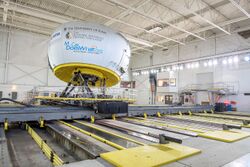Software:National Advanced Driving Simulator
The National Advanced Driving Simulator (NADS) at the University of Iowa College of Engineering is among the largest[clarification needed] ground vehicle driving simulator in the world along with Toyota's driving simulator at Higashifuji Technical Center.[1]
National Highway Traffic Safety Administration (NHTSA) owns the NADS-1 simulator, while the University of Iowa takes responsibility for operation and maintenance.
Mission
Make roads safer by researching the connection between humans and vehicles
Driving research
Research is done with both simulators and on-road vehicles. Funded by government and industry partners, their expertise includes:
- Human factors
- Distracted driving
- Drowsy driving
- Drugged driving
- Connected and automated vehicles
- Mobility
- At-risk populations (older and novice drivers)
- Simulation science
- Crash biomechanics
- Safety and crash data analysis
Simulators
NADS-1 simulator: One of the world’s most realistic driving simulators
NADS-2 simulator: A fixed-base simulator with high-resolution graphics
miniSim™: A low-cost PC-based portable simulator available for purchase
The NADS-1 simulator consists of a dome with a vehicle cab inside. The vehicle is attached to a motorized turntable that allows the dome to rotate and simulate different driving conditions. 64 feet of longitudinal and lateral travel and 330 degrees of rotation are used to give motion cues to the driver inside. Different makes and models of car cabs can be utilized. The driving simulator was designed, developed and produced by MTS Systems Corporation of Eden Prairie, Minnesota.[2] The simulation runs using a software package called Real Time Recursive Dynamics (RTRD), as well as NADSdyna submodules for specific vehicle specs.[3][4]
On-road research vehicles
The National Advanced Driving Simulator faculty and staff also use a fleet of on-road, custom instrumented vehicles to conduct driving research, in addition to their suite of simulators:
- Tesla Model S75D
- Lincoln MKZ
- Volvo XC90
- Toyota Camry XLE
- Ford Transit shuttle bus
History
The National Advanced Driving Simulator was developed from 1996 through 2001 by the National Highway Traffic Safety Administration (NHTSA) to conduct human factors research on driver behavior.
1992
NHTSA selects the University of Iowa to house the National Advanced Driving Simulator (NADS), which would become the most sophisticated research driving simulator in the world.
1994
The first automated driving simulations in the world are done at the University of Iowa. Forward collision warning and ACC systems are designed, developed, and tested for NHTSA.
1997
NADS begins building virtual replicas of military proving grounds, such as the Aberdeen Proving Ground in Maryland, where the government tests military vehicles.
1998
Ground is broken for the new NADS facility.
1999
UI begins first drugged driving study: “Effects of Fexofenadine, Diphenhydramine, and Alcohol on Driving Performance.”
2001 (fall)
NADS-1 is operational. The facility is operated on a self-sustaining basis by the UI. NHTSA owns the simulator while the UI takes responsibility for operation and maintenance. UI owns the building, land, and the software that runs the NADS-1.
2001
The first formal study done on the NADS-1 is a study on tire failure and loss of control.
2002
A wireless phone study is conducted—the first at NADS about driver distraction.
2003
NADS begins work with John Deere, and a tractor cab is created for use in the NADS-1 simulator.
2005
NADS builds a portable simulator for outreach to high school students, which eventually leads to the creation of the miniSim program in 2009.
2006
- The NADS-2 simulator—the second simulator at NADS—is ready for business.
- Based partially on research done at NADS, NHTSA mandates that all new vehicles must have electronic stability control.
2011
- The first cannabis study on driving performance is conducted at NADS.
- The first on-road vehicle is purchased for NADS research, a Toyota Camry.
2013
NADS is awarded a grant that would grow to $11.2 million over eight years from the U.S. DOT to fund SAFER-SIM: Safety Research Using Simulation.
2015
MyCarDoesWhat.org campaign launched to educate consumers about advanced driver assistance systems.
2016–2018
Automated vehicles are added to the NADS fleet: a Volvo XC90, Tesla Model S75D, and Lincoln MKZ.
2019
U.S. DOT awards NADS a $7 million grant for the Automated Driving Systems for Rural America project.
References
- ↑ Chang, Kuang-Hua (February 3, 2013). Product Performance Evaluation using CAD/CAE: The Computer Aided Engineering Design Series. Academic Press. p. 194. ISBN 9780123984692. https://books.google.com/books?id=tc47vqyr4GAC&pg=PA192.
- ↑ Bartolo, Paulo Jorge da Silva (September 15, 2005). Virtual Modelling and Rapid Manufacturing: Advanced Research in Virtual and Rapid Prototyping Proc. 2nd Int. Conf. on Advanced Research in Virtual and Rapid Prototyping, 28 Sep-1 Oct 2005, Leiria, Portugal. CRC Press. pp. 77–78. ISBN 9780415390620. https://books.google.com/books?id=jdiNh0CXxPgC&pg=PA77.
- ↑ Christos, Jeffrey P.; Grygier, Paul A.. "Experimental Testing of a 1994 Ford Taurus for NADSdyna Validation". http://nhthqnlas188.nhtsa.dot.gov/DOT/NHTSA/NRD/Multimedia/PDFs/VRTC/ca/capubs/taurus_test.pdf. Retrieved 27 December 2013.
- ↑ Salaani, M. Kamel; Dennis A. Guenther; Gary J. Heydinger (1999). "Vehicle Dynamics Modeling for the National Advanced Driving Simulator of a 1997 Jeep Cherokee". SAE Technical Paper Series. 1. SAE International. doi:10.4271/1999-01-0121.
External links
- Stall, Douglas A.; Bourne, Simon (January 15, 1996). "National Advanced Driving Simulator: Potential Applications to ITS and AHS Research". http://ntl.bts.gov/lib/9000/9400/9429/LY01.pdf. Retrieved 27 December 2013.
[ ⚑ ] 41°42′29″N 91°36′06″W / 41.7080°N 91.6017°W


